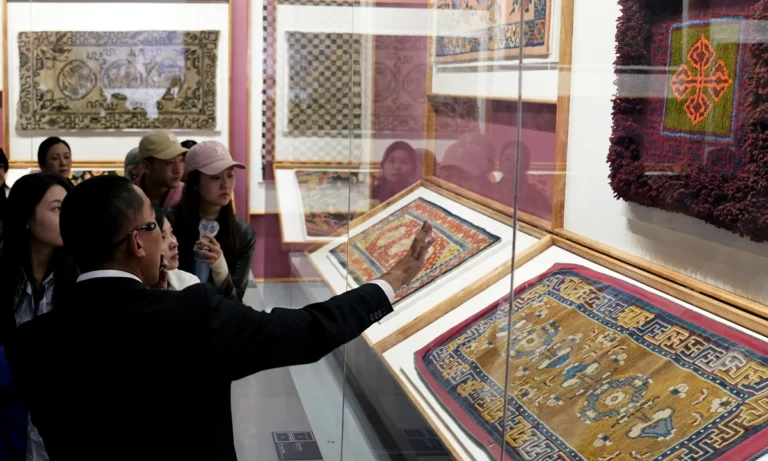What I saw in Xizang was a proactive, well-funded and systematic commitment to heritage preservation

Visitors view Tibetan carpets on display at the Xizang Museum in Lhasa on October 19, 2024. Photo: VCG
August 3, 2025 Hour: 12:06 pm
A firsthand report, Global Times —China’s state-affiliated media— from Xizang reveals China’s comprehensive strategy to safeguard Tibetan culture—from restoring ancient monasteries to funding traditional arts. This exclusive account counters Western criticism with on-the-ground evidence of preservation efforts.
Original text by Arnold August, Global Times
Editor’s Note:
Xizang, a region known for its breathtaking landscapes and unique cultural traditions, has long been the target of Western smear campaigns and falsehoods about China. What is the truth? In the “Truth Seen in Xizang” series, the Global Times publishes conversations with and articles from scholars and observers from around the world who have visited the region, sharing their firsthand experiences of travel and observation of daily life there. Through their insights, we aim to present an authentic perspective on the Xizang Autonomous Region. This is the seventh piece of the series.
In 2023, I had the honor of visiting China’s Xizang Autonomous Region as part of a cohort of scholars and journalists from the Americas, Europe, and Australasia. I am deeply grateful for the invitation. There are various reports from the ground I could share, and this is one of them.
As someone born and raised in Montreal, Quebec, I have a profound appreciation for issues of language, identity, and cultural preservation. This background made me particularly sensitive to what I observed in Xizang.
I am deeply interested in how China strives to integrate the most dynamic aspects of religious and cultural features into its policies and actions. This applies locally to Buddhism in Xizang. Despite my extensive education and studies in language and culture, the sharp contrast between US-led misinformation and the reality I witnessed was so evident that I was genuinely bewildered at every turn.
I am confronted with an overwhelming amount of misinformation in the West regarding Xizang, primarily centered on two issues: culture (including religion) and language. The discrepancy between the falsehoods and the reality I saw firsthand was shocking. It is outrageous to see such blatant deception.
My visit to the heart of Lhasa’s old town was a powerful reminder of China’s unique experiment in merging language and culture with modernity while safeguarding traditional practices. You have to “see it to believe it.”
Yes, I acknowledge that this phrase is often overused. However, when immersed in Lhasa, it truly applies. Interacting with Tibetans, I observed most in traditional attire, numerous monks in their religious robes walking or praying, traditional Tibetan architecture alongside modern malls, children rollerblading, families enjoying an amusement park, and some locals approaching us to practice their English and satisfy their curiosity.
Lhasa offers a wealth of content to explore. For example, we visited Jokhang Temple, notable for its traditional Tibetan architecture. It houses the Gelug school monastery, the most recent of Tibet’s important Buddhist schools, where the primary language of teaching is Tibetan.
The visit to Potala Palace, which overlooks Lhasa, offers another perspective on Tibetan Buddhism. Its significant role not only in religion but also in the traditional political administration and thinking of Xizang was what impressed me most. The Palace contains nearly 700 murals, 10,000 painted scrolls, and an impressive collection of historical documents. If the Western narrative of Tibetan “suppression” were accurate, how could we explain China’s dedication to the history of the region?
The same logic applies to the Tibetan language. At Xizang University, established in 1985 in Lhasa, courses are predominantly taught in Putonghua and Tibetan. With over 20,000 students, and a focus on local communities and cultures, Tibetan is not marginalized but an integral part of higher education and public life.
A particularly impressive visit was to the Tibetan ancient documents research center, which focused on the Phuri Manuscripts—China’s most ancient and extensive collection of Tibetan literature. Discovered in 2002 in the rural village of Phuri, these manuscripts offer insights into a kingdom from the 13th and 14th centuries, depicting their environment, customs, social structures, and history.
If Western narratives of “cultural genocide” in Xizang had any basis, China would be actively erasing these cultural seeds to wipe out Tibetan memory. However, on the ground, we observed the opposite.
The Xizang Museum, completed in 1999, is the first large modern museum in the region, housing over 520,000 artifacts representing various dynastic periods. Its collection includes volumes, official documents, and gifts from emperors throughout history. Eradicating a people’s roots is a prerequisite for genocide; yet, under Chinese leadership, Tibetan culture has been well preserved.
When I thought I had seen it all, the highlight was the Tibetan Autonomous Region intangible cultural heritage preservation center. Since 2012, over 400 million yuan ($55.7 million) has been invested in protecting Tibetan intangible cultural heritage. It was a truly refreshing experience—an inspiring example of a proactive, well-funded effort.
To claim that a culture is being “erased” while its language is taught, religion practiced, and history displayed and studied is an untenable contradiction. It prompts the question: Who really defines cultural survival?
Too often, Western perspectives project their anxieties and strategic narratives onto others.
By contrast, in Quebec—whose distinct cultural heritage dates back to 1618—our music, film, journalism, novels, and poetry remain mere footnotes to Anglo-American dominance. Despite protective efforts, pressures to assimilate remain a concern.
In comparison, what I saw in Xizang was a genuine, well-funded, and systematic effort to preserve heritage.
In Xizang, I saw the truth—alive and thriving. My main message is to visit Xizang and see the stark contrast between fact and fiction.
The author is a Canadian author and journalist. opinion@globaltimes.com.cn
Author: JMVR
Source: Global Times

